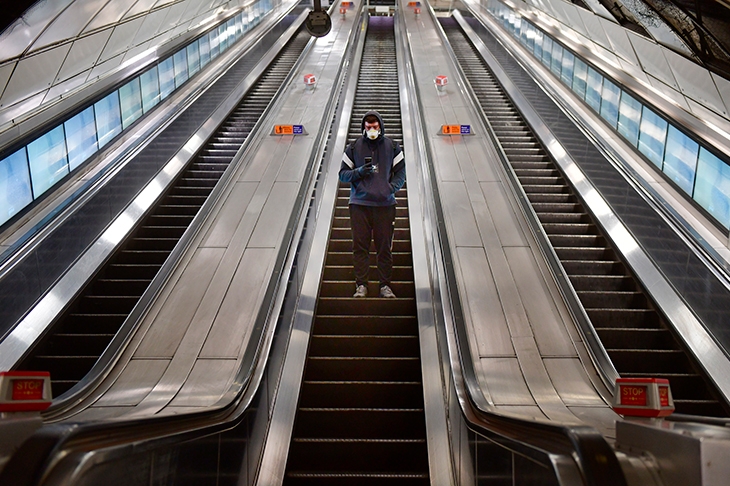‘Nothing makes sense in biology, except in the light of evolution,’ the splendidly named biologist Theodosius Dobzhansky wrote in 1973. It’s a good rule of thumb. Despite near-miraculous advances in medical science we remain biological beings, subject to biological laws. None is more central to our understanding of disease than evolution. Yet this theory remains poorly understood and poorly utilized in medicine. And an evolutionary perspective raises important questions about the drastic action we have been taking to confront COVID-19.
Most doctors are too busy dealing with the day-to-day deluge of cases to have much time for what they may consider abstruse academic ideas. I can see why: it’s hard enough to understand diseases, let alone think about how they might be changing as we watch. But we know a lot about viruses and their evolution, and this perspective seems relevant (if largely overlooked) now.
So far, in most commentary on this pandemic, it has been assumed that we are dealing with an unchanging threat. Sars-CoV-2 is a new type of virus that is attacking people, causing a disease called COVID-19. The extent of the threat is constant and can be assessed by examining what happened in places where the pandemic is ‘further ahead’. We know that a certain proportion of patients develop mild disease. Others suffer a much more severe infection. These figures are assumed to be a consistent feature of the new virus: it affects some worse than others.
But an evolutionary approach suggests a different view. What if there are different versions of this coronavirus — some less deadly than others? All viruses mutate. Typically, a rapidly spreading virus tends to become less harmful as it changes because this helps it survive. If the virus kills too many of its hosts, it is more likely to die out. If it becomes milder, it spreads further. Unlike some viruses that spread slowly and can be fairly quickly suppressed by case isolation, Sars-CoV-2 spreads quite easily. We know that it can evolve, because it has recently colonized humans. To understand why it is still evolving further, you have to grasp just how small a virus is.
Imagine a birthday balloon. A virus is smaller than this by roughly the same amount that the balloon is smaller than the earth (think about that for a moment: balloon, earth; virus, balloon). When a person is infectious with a virus, it is estimated that they may excrete 1011 virus particles a day. Even if 99.99 percent of the particles were destroyed on contact with the air, there are still a huge number of infectious ones left.
These particles will not all be identical. Evolution is driven by inaccuracies in biological copying. COVID-19 is caused by a single–stranded RNA virus, a type particularly susceptible to copying errors. So much so, in fact, that viruses of this group are often referred to as ‘quasi-species’ because they are so variable. It’s likely that some particles of this virus infect their victims with a slightly less severe form of COVID-19, making them less ill. And so, on average, those people will be more likely to continue with their normal daily activities outside of a lockdown, going to work or out shopping. In short, they will be more likely to spread the virus to others.
In contrast, the particles that cause more severe COVID-19 disease will be spread less since the people who feel worse will circulate less. Hence the evolutionary effect: more severe versions of a new virus tend to decrease quite quickly over time, because the milder versions get spread around more. But change the circumstances — change the environment in which the virus exists — and it could go the other way.
Think about the lockdown. We have substantially reduced the number of people circulating in the community. If lockdown is working, and stopping the spread of the virus, it might be reducing the circulation of milder versions among the population, while at the same time concentrating people with the most severe disease in hospital wards. There we can find the perfect viral storm, containing everything needed for rapid evolution: huge numbers of reproducing units (the virus), an environment for rapid reproduction to take place in (patients and staff), and selection pressures (things that alter how the virus spreads, such as density of people, severity of disease, or length of survival).
All of this raises an important question: might lockdown be frustrating a helpful evolutionary tendency of the virus, as well as economically hindering our ability to deal with it? The epidemiological models are silent on this. Most studies so far suggest that this virus is not mutating in a way that meaningfully changes its nature. But we are learning more about COVID all the time.
A recent paper from China employed a more thorough sequencing technique than generally used to examine the virus from a small number of cases. Standard quick-but-superficial sequencing methods have already revealed more than 4,000 mutations in the virus. But the detailed method revealed 19 new, overlooked mutations in just 11 patients, and these mutations altered the infectivity of the virus. The most aggressive strain generated a viral load that was 270 times greater than the weakest one, and also killed cells fastest. This is the first direct evidence for the effects described above, namely that mutations in this virus can affect the severity of disease. And with such a maelstrom of mutation going on below the surface of standard detection methods, it is entirely possible that an intervention as drastic as lockdown could be having negative effects on the evolution of the virus itself that we don’t appreciate.
So the question remains: is it better to lock everyone down in hope of reducing a wave of severe cases, but with no real understanding of the wider effects on the virus or society at large? Or would it have been better to adopt what’s often described as the ‘herd immunity’ strategy and let the virus continue to circulate among younger, fitter people, diminishing its severity, while doing our best to protect and support those with greater vulnerabilities? In this view, spread of the virus by people with no symptoms is a good thing because it helps the virus get milder more quickly. Now, more than ever, we need robust and open discussion about whether we are on the right course.
This article was originally published in
The Spectator’s UK magazine. Subscribe to the US edition here.

























